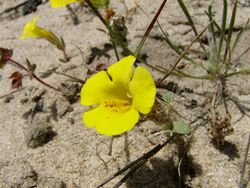Biology:Diplacus vandenbergensis
| Diplacus vandenbergensis | |
|---|---|

| |
| Scientific classification | |
| Kingdom: | Plantae |
| Clade: | Tracheophytes |
| Clade: | Angiosperms |
| Clade: | Eudicots |
| Clade: | Asterids |
| Order: | Lamiales |
| Family: | Phrymaceae |
| Genus: | Diplacus |
| Species: | D. vandenbergensis
|
| Binomial name | |
| Diplacus vandenbergensis (D.M. Thomps.) Nesom.
| |
| Synonyms[1] | |
| |
Diplacus vandenbergensis, commonly known as the Vandenberg monkeyflower, is a species of Diplacus located in the Phrymaceae family.[2] It grows as a small herbaceous annual plant and is native to the Burton Mesa Ecological Reserve in Santa Barbara County, California.[3] According to the U.S. Fish and Wildlife Service it is an endangered species and hence was allocated critical habitat within the reserve in 2014.[4]
Description
This annual plant grows roughly to a height of 20 cm (8 in) before it releases seeds and dies. The leaves are 2–30 mm (0.08–1 in) long and are generally narrowly elliptic in shape. The yellow flowers emerge between May and June, with the pedicel being 1–4 mm long and the calyx 5–14 mm. The tube/throat of the flower is 9–23 mm long. The fruit is 6.5–13 mm long.[2]
Habitat
The primary habitats of this species are chaparral, cismontane woodlands and coastal dunes.[3] It grows in sandy soil between larger shrubs where it receives increased protection from external threats such as wind and animals. Influx of these small areas by invasive plant species such as Pampas grass, Veldt grass and Iceplant pose the greatest risk to this species.[5] It is also threatened by development and off-road vehicles.[3]
References
- ↑ Diplacus vandenbergensis Calflora, https://www.calflora.org/cgi-bin/species_query.cgi?where-calrecnum=13400, retrieved 28 December 2018
- ↑ 2.0 2.1 The Jepson Herbarium, University of California, Berkeley, http://ucjeps.berkeley.edu/eflora/eflora_display.php?tid=99080, retrieved 28 December 2018
- ↑ 3.0 3.1 3.2 CNPS Inventory Plant Detail, http://www.rareplants.cnps.org/detail/3147.html, retrieved 28 December 2018
- ↑ Final Rule to Designate Critical Habitat for Vandenberg Monkeyflower, https://www.reginfo.gov/public/do/eAgendaViewRule?pubId=201410&RIN=1018-AZ33, retrieved 28 December 2018
- ↑ Rare Santa Barbara Wildflower Endangered, Say Feds, 30 October 2013, https://www.kcet.org/redefine/rare-santa-barbara-wildflower-endangered-say-feds, retrieved 28 December 2018
External links
- Federal Register - Designation of Critical Habitat for Diplacus vandenbergensis
- Jepson Herbarium - Detailed plant profile
Wikidata ☰ Q17746287 entry
 |

